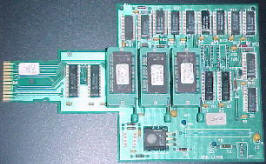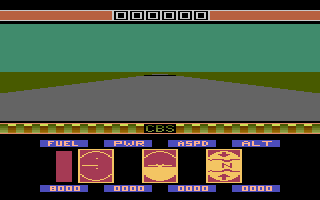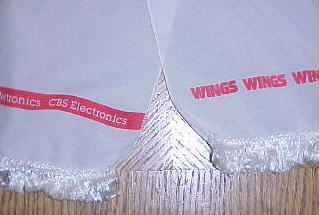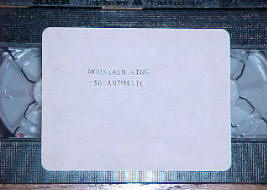

... Stuart Ross
By Scott Stilphen

I had a chance to speak with former CBS Electronics video game programmer, Stuart Ross, on his experiences with designing games for the Atari 2600 back in the early 80s, and how and why his greatest (and only) game for that system never got released.
The creation of CBS’s video game division…
The person responsible was Rob Hunter. He was a 28-year-old VP at CBS. His ‘claim to fame’ was signing the band Journey to CBS’ record label. It was his idea to create a video game group. He came to the technology center, which was in Stafford, CT, and there was a toy development group that was managed by Trevor Marshall. Rob tapped him to help build this group, which is where Rob found Ed Pryzby and me. He ran the toy development group at CBS labs. Ed Pryzby was the first original hardware guy. He did a lot of 4 and 8-bit programming for the early electronic toys (Clip Clop the Wonder Horse, fire engine toys, etc.). I had all the 6502 experience, so reverse-engineering the 2600 was no big deal to me. The 3 of us rolled up our sleeves and dove into this thing.
In the early days the first few games were contracted out to other programmers, who would basically use up the 4k they had and then stop. My first job was going with Rich Ekerstrom (the producer) out to Chicago to meet with whoever the programmer was (usually at the worst time, like a Friday night, so they weren’t too happy to see us) and they’d have a little office in their home with an emulator set up. And we’d say “Gorf needs to do this” and they’d say “It can’t, because we’re out of space” so I’d have him print out a big green-bar paper (source code) listing and then I’d sit down and take a marker and find bytes we needed. By then Rich would be back with a pizza and it’d be 10:30, so we’d work on optimizing the code, which might take until about 1am. So the programmer would sit back and think “Ah, this is great. Now I can get paid…” and then Rich would so “Ok, well you did that. Now we need to handle this.”, and he’d have a list of functions and features that needed to be in the game, and the programmers eyes would just bug out. And the process would start all over again.
As we built the group, eventually we started tapping people from other departments, and then hiring from the outside. It eventually grew out of CBS labs. They took this place in Greenwich and renovated it, and built all these beautiful offices with special ventilation so that it’d be quiet, which was a ridiculous waste (in the shadows of the 70s). The whole building was 4 or 5 thousand square feet, and included a major conference room, with a focus room off it that had 1-way glass. On the other side of the glass was an arcade that had all the Bally-Midway games. Every programmer had their own office with a door. Rob Hunter was a ‘golden boy’ in the sense that he could do no wrong, so they basically gave him a blank check…and he spent it! We use to go off to Cape Cod for think-tank sessions, and one time they flew in a guy from Disney to talk with us about creativity, and how that process works, which probably cost like $5k back then in those days! There were a lot of excesses. They had a special hardware lab, and so on. We (Ed) had a train set that ran around up by the ceiling. These (very conservative) guys would sometimes come up from corporate to visit, decked out in wingtip shoes, and see things like that….
Tunnel Runner and RAM Plus carts…
Originally Tunnel Runner was going to have holes in the floors. You were trapped in a cube and you had to get out before it exploded. We eventually discarded that and went with more of a Pac-Man rip-off thing. The idea was to do all 3-D games, since nobody was doing them, so that’s where Tunnel Runner and Wings came from. We quickly realized that we needed the (extra) RAM Plus carts just to code them, which was beyond what you could do with moving stuff around in 2-D. You needed data tables and other “expensive” things. So this led to the development of the RAM Plus carts:

Original “Black Box” concept drawing for Tunnel Runner, dated 4/1/82
Below is a RAM Plus emulator called the “Scott box”. It was designed by Scott Robinson and Ed Pryzby. You can see the 3 banks on it, which have the last version of Wings (10/10/83).


Wings…
The development time was about 16 months. I remember
trying to figure out how to roll stuff on the radar screen appropriately,
because you couldn’t actually track the radar screen to the map. It was too
complicated. So I came up with this little algorithm that would state what
should happen, but it required 55 bytes. To do all the things in 3-D in Wings
required vectoring objects, but you can’t do trig in that thing with only 10.5k,
so it was all a “guestimation”. The real trick was, how do you roll something
on the screen when you bank the airplane, because you want the objects to move.
The earlier version was just trying to figure out where to place, how the map
was going to work, what happens (on the screen) when something moves when the
plane would roll, how the direction heading would work, how the world
coordinates system would work (since it was going to be played in the ‘real’
world), and using all this “matrix” algebra to figure out how all this gets
translated so that when something moves – what happens? And then it (the
programming difficulty) got worse…and worse...and worse by the time I ended up
at the point of doing the ‘view port’ transformation, because then you had to
figure out how large or small an object should appear, and where to place it on
the screen (in XY coordinates). So I ended up with adding two variables
together, and using look-up tables. Divisions were done by the power of 2, for
shifting to the left or right. The machine could add and subtract, and you
could divide by 2, 4, 6…the problem was doing multiplicatio n sucked! I decided
later that if we just made an algorithm to rotate the screen 1 through 256, and
then all I had to do when things came into view, was figure out how many times
to redraw the screen, so objects ended up end up using sines and cosines and
you’d have to multiply with that fraction - that number was really equal to 1/64
+ 1/128. The final was an approximation of what it should be (because the actual
value was just … “There’s no way!”) but it was real close. So you can get these
values by simply taking the coordinate you had and shifting it like 8 times to
the right and adding it to being shifted to the right 9 times.
n sucked! I decided
later that if we just made an algorithm to rotate the screen 1 through 256, and
then all I had to do when things came into view, was figure out how many times
to redraw the screen, so objects ended up end up using sines and cosines and
you’d have to multiply with that fraction - that number was really equal to 1/64
+ 1/128. The final was an approximation of what it should be (because the actual
value was just … “There’s no way!”) but it was real close. So you can get these
values by simply taking the coordinate you had and shifting it like 8 times to
the right and adding it to being shifted to the right 9 times.
The game was basically finished (although marketing wanted clouds added…which were never implemented). We were about 2 weeks from having Wings ROMS manufactured when CBS pulled the plug. They even had some promotional material ready (hats and scarves), as well as a TV spot!



CES experiences…
We would swipe competitor’s carts right off the show floor, as did other companies, but until the statute of limitations runs out, I can’t tell you too much about that! At the first shows, we had ours tethered with press fittings and stainless steel wire, but after that CBS decided that wasn’t good enough. They wanted more exposure so we built these things:



This was the bane of Harry Clayton and Ed Pryzby. It’s called a game switcher and it could have up to 6 games in it. CBS made a couple of these, and the final ones were soldered in the Sands Hotel in Las Vegas! The ribbon cable went to a cartridge, which then got plugged into a VCS, so that they could have up to 6 different games shown at each booth. By hitting either SELECT or RESET, you could change games. From what I recalled the switchers seemed to work pretty well, though there might have been a problem with noise because of the long cable.
As you can see, there are still some ROMs in it (Solar Fox, Targ, Tunnel Runner, and Wings). Wings is dated 6/3, so this would have been the version shown at CES. In those days everybody had a demo, even if it was just an inkling of something being shown. The first thing we showed at a CES was a demo of a bouncing ball, similar to the famous Amiga ball demo. We had about 20 Bally/Midway coin-ops in our area, and then in the front on one pedestal we had 2 VCS systems running our first ‘cartridges’, which had this demo. The “ball” was a big red CBS “eye” with “CBS” under it, which spun and bounced.


Metal “Wings” plate from Summer 1983 CES display
The crash…
I think half of CBS wanted to get out. They were a very old-school business, and along came this whole (2600) thing that shattered that, because they had to pay people who, despite the love of the company, the competitive salary range for programmers didn’t exist back then. People would pop up and start up an “Activision” or go independent, and these people were driving Porches. So how were they going to incentive-ize us? That was a problem because their policy book had specific salary ranges and places, and scales of class. By the end of 1983 rolled around though, even Activision was posting big 3rd-quarter losses, and you had this group of people whose spending was out of control, so I think they were glad to be done with it. It’s too bad they didn’t stick around. With their distribution and their label, they were really a content company, and they could have been a software giant. But they didn’t have that kind of “attention span”, so here we are 20 years later and CBS is a broadcast division of a different corporate entity - radio and TV – and that’s it. Everything else was sold off, which went on to flourish, such as Fender (guitars). Their motto was always seemed to be ‘find a good thing, and beat it to death’!

CBS internal Atari VCS Display Timing Chart, dated 5/4/82
Then and now…
As the (ROM) size of games grew, the essence of creativity changed. It became more a process of turning a crank. In the old days we’d struggle to find 5 bytes to put a game feature in; every byte was precious. With the CD, suddenly you had 650 megabytes, and the problem was people felt obligated to fill it up, and so the cost of doing a game wasn’t 1 person over 5-6 months to fill 4k with something carefully crafted - now you had 20 artists rendering pictures because you had room for them, and the development cost went up to like a million dollars. But you only had so much self space, to the extent that maybe only the top 10 CD titles made any money in the early 90s. Everything else was a sinking ship, so you had a shaking out period. It came back thanks in part to companies like Nintendo and Sony catching up and stabilizing it to the point that it’s all a genre now. What’s amazing to me is that I can go into a store now and get a refurbished Nintendo 64 for like $15. The lifespan of systems just isn’t what it was.

Promotional sew-on patch
Memories from those days…
New York Times came to interview us for an article on video game designers, which was the hot trend at the time. When they were interviewing Scott Santulli, he was sitting there playing Burgertime the whole time, just to show how he could roll it. Anyway, he said the best game of all is making them up! We once duct-taped Scott to his (new) 5-wheeled desk chair b/c he was “out of control” (4-wheeled chairs were still common, but they always had a tendency to tip over). He threatened to tell on us about something, so we retaliated! I also have some promotional photos somewhere of Bucko and myself buried up to our necks in green-bar paper! There was definitely some “Fear and Loathing in Video Games” in those days! When Mountain King came around - the name of which I can’t even stand to hear - it was all about the theme, so we always heard the tune to that song playing in the background. Ed Pryzby was also an excellent musician, and he’d go buzzing around the building just whistling that tune all the time, just to annoy people. You had to be nuts to program for the 2600. Seriously, you had to have some sort of chemical imbalance to do it – and most of us did! Even Kate McCallum, who was our secretary, was guilty of this. She once managed to get a thousand business cards printed up for my roommate, but with her phone number on them!


CBS internal copies of TV commercials for Tunnel Runner, Solar Fox, Wings, and Mountain King
To learn more about Stuart Ross’ current company, Motion Media, and their work with video phones, check out their website, at: http://www.scottygroup.com/
To see the TV commercials, head over to the pictures & video section.
| GAMEOLOGY |
| GAME | SYSTEM | COMPANY | STATUS |
| Wings | Atari VCS/2600 | CBS Electronics | unreleased |
| Bill & Ted's Excellent Video Game Adventure | NES | LJN | released |